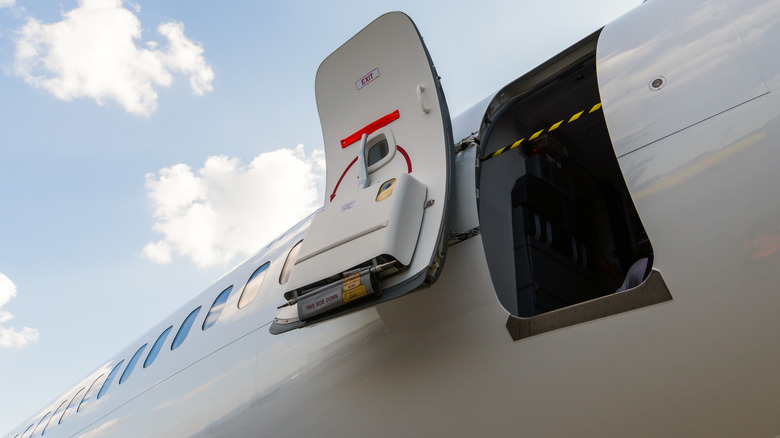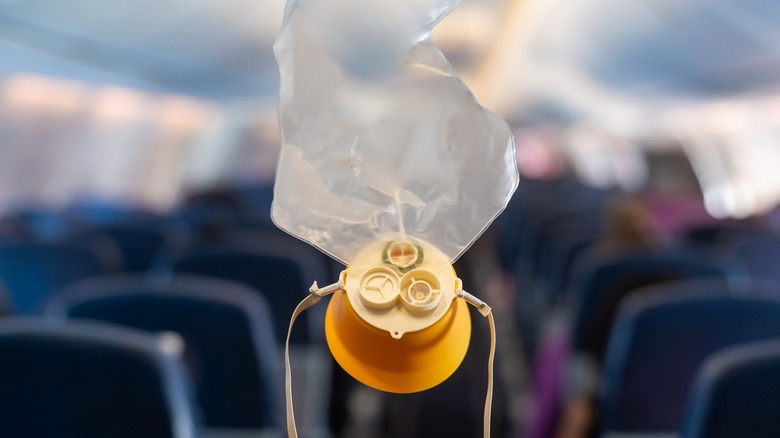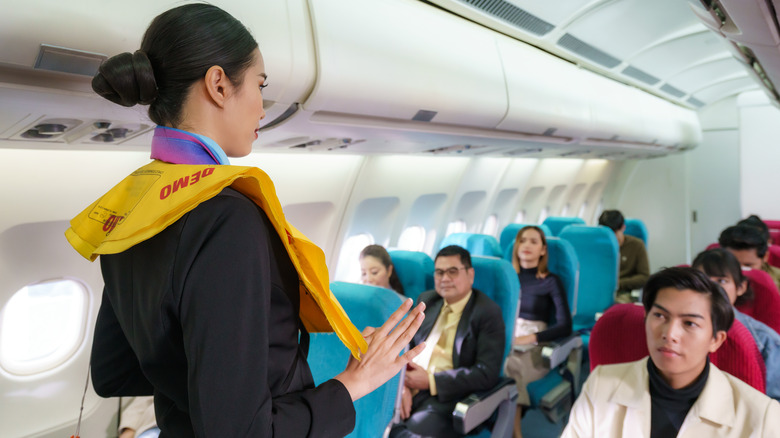What To Do If An Airplane Door Flies Off During Your Flight
While the idea of a window shattering or a cabin door coming unhinged mid-flight might sound like the stuff you can only find in films, these exceedingly rare incidents can and do occur in real life. Thankfully, you already know the actions you should take during this harrowing incident, all thanks to the safety demonstrations provided at the start of each flight.
In case you missed it, an Alaska Airlines flight made headlines in January 2024 when one of its cabin doors detached from the body just shortly after takeoff. According to The Washington Post, the plane had to do an emergency landing, and remarkably, all passengers and crew landed safely. "There was a really loud bang ... and then a whoosh noise and all the air masks dropped," passenger Evan Smith told Fox12 Oregon of the incident. Another passenger, Elizabeth Le, shared that it was nothing short of "terrifying," noting that "everyone was shaken up but we all remained calm and buckled in our seats."
It was a high-stress situation, to say the least, but it turns out that Le and the rest of the passengers were right in their decision to maintain their composure. Your first instinct might be to panic, but the real lifesaver is to keep a level head, strap on your oxygen mask, and stay put in your seat.
Buckle up and wear your oxygen mask
In the unlikely event that an airplane door dislodges mid-flight, the aircraft kickstarts depressurization immediately. This is necessary because the plane loses its controlled cabin pressure through the hole, making it a critical situation, especially if the plane is cruising above 18,000 feet. At such altitudes, the circulating air outside lacks the needed oxygen for normal breathing, posing a risk of hypoxia to everyone on board. Pilots are trained to descend to at least 10,000 feet, where the air allows for comfortable breathing without outside help.
Flight attendant Carrie A. Trey explained to The Points Guy that during depressurization, donning your oxygen mask is critical. As soon as it drops, wear it ASAP. "At 35,000 feet, you have 30 seconds before you pass out to get an oxygen mask on," she explained, adding that as the plane descends, you'll also feel simultaneous sensations all at once: your ears popping, a rush of cold air, the cabin covered in fog, and an unsettling feeling of falling.
Trey also advises passengers to remain as still as possible, intervening only if they have the credentials to lend a helping hand. "If you're specially qualified — EMT, military, whatever — jump right in. Or if you're in the immediate area, and the flight attendants ask you to help," she noted. "But if you're not genuinely contributing, stay out of it, and keep your cell phone out of it, yourself out of it. And if you have to question whether or not you're contributing? You're not."
Don't take safety briefings for granted
Facing an emergency without spiraling into panic is far more achievable when you're armed with knowledge of how to react. And where does this crucial information come from, you ask? Simply by tuning into the flight attendant's safety demonstrations. Sure, they may be repetitive and may sometimes be borderline cheesy, but they are a vital aspect of flight safety. Regardless of how many times you've heard the familiar spiel, "In the event of a loss of cabin pressure, the oxygen masks will deploy," it's still important to listen up. Every aircraft is unique, after all, and may come with specific safety procedures.
Ignoring the safety instructions until an emergency actually unfolds is a mistake you definitely don't want to make. Risk management expert Jack Plaxe told The Washington Post that paying close attention to these briefings enhances your survival in crashes, or any aviation-related incident for that matter. "After meeting air-crash survivors and families who lost loved ones in disasters, I learned that safety is critical to survival and that the flight attendant's safety briefing is the first step to prepare for the flight," he explained.
While you're at it, you'll want to browse the safety cards tucked in the seat pocket in front of you as well. They can end up saving your life. As Sara Nelson, president of the Association of Flight Attendants, told The Points Guy, "In general, a passenger who listens to the safety briefing is a safer passenger."


